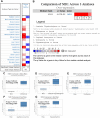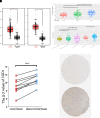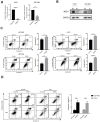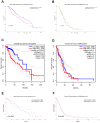Nidogen-1 expression is associated with overall survival and temozolomide sensitivity in low-grade glioma patients
- PMID: 33735110
- PMCID: PMC8034893
- DOI: 10.18632/aging.202789
Nidogen-1 expression is associated with overall survival and temozolomide sensitivity in low-grade glioma patients
Abstract
We investigated the prognostic significance of nidogen-1 (NID1) in glioma. Oncomine, GEPIA, UALCAN, CCGA database analyses showed that NID1 transcript levels were significantly upregulated in multiple cancer types, including gliomas. Quantitative RT-PCR analyses confirmed that NID1 expression was significantly upregulated in glioma tissues compared to paired adjacent normal brain tissue samples (n=9). NID1 silencing enhanced in vitro apoptosis and the temozolomide sensitivity of U251 and U87-MG glioma cells. Protein-protein interaction network analysis using the STRING and GeneMANIA databases showed that NID1 interacts with several extracellular matrix proteins. TIMER database analysis showed that NID1 expression in low-grade gliomas was associated with tumor infiltration of B cells, CD4+ and CD8+ T cells, macrophages, neutrophils, and dendritic cells. Kaplan-Meier survival curve analysis showed that low-grade gliomas patients with high NID1 expression were associated with shorter overall survival. However, NID1 expression was not associated with overall survival in glioblastoma multiforme patients. These findings demonstrate that NID1 expression in glioma tissues is associated with overall survival of low-grade glioma patients and temozolomide sensitivity. NID1 is thus a potential prognostic biomarker and therapeutic target in low-grade glioma patients.
Keywords: NID1; apoptosis; basement membrane; glioma; temozolomide.
Conflict of interest statement
Figures








Similar articles
-
Bortezomib inhibits growth and sensitizes glioma to temozolomide (TMZ) via down-regulating the FOXM1-Survivin axis.Cancer Commun (Lond). 2019 Dec 3;39(1):81. doi: 10.1186/s40880-019-0424-2. Cancer Commun (Lond). 2019. PMID: 31796105 Free PMC article.
-
Analysis of expression and prognostic significance of vimentin and the response to temozolomide in glioma patients.Tumour Biol. 2016 Nov;37(11):15333-15339. doi: 10.1007/s13277-016-5462-7. Epub 2016 Oct 4. Tumour Biol. 2016. PMID: 27704357
-
Thioredoxin related transmembrane protein 1acts as a prognostic indictor and promotes proliferation and TMZ resistance of lower-grade glioma.Sci Rep. 2025 Feb 12;15(1):5246. doi: 10.1038/s41598-025-89908-y. Sci Rep. 2025. PMID: 39939413 Free PMC article.
-
ABCC8 mRNA expression is an independent prognostic factor for glioma and can predict chemosensitivity.Sci Rep. 2020 Jul 29;10(1):12682. doi: 10.1038/s41598-020-69676-7. Sci Rep. 2020. PMID: 32728190 Free PMC article.
-
Integrated bioinformatics analysis and experimental validation on malignant progression and immune cell infiltration of LTBP2 in gliomas.BMC Cancer. 2024 Oct 10;24(1):1252. doi: 10.1186/s12885-024-12976-2. BMC Cancer. 2024. PMID: 39390437 Free PMC article.
Cited by
-
Germline Non-CDKN2A Variants in Melanoma and Associated Hereditary Cancer Syndromes.Diseases. 2025 Jun 9;13(6):180. doi: 10.3390/diseases13060180. Diseases. 2025. PMID: 40558591 Free PMC article. Review.
-
Association of NID2 SNPs with Glioma Risk and Prognosis in the Chinese Population.Neuromolecular Med. 2024 Jun 27;26(1):27. doi: 10.1007/s12017-024-08795-0. Neuromolecular Med. 2024. PMID: 38935278
-
Role of the ITAM-Bearing Receptors Expressed by Natural Killer Cells in Cancer.Front Immunol. 2022 Jun 10;13:898745. doi: 10.3389/fimmu.2022.898745. eCollection 2022. Front Immunol. 2022. PMID: 35757695 Free PMC article. Review.
-
NID2 Affects Prognosis of Glioma via Activating the Akt Signaling Pathway.Int J Mol Sci. 2025 Apr 18;26(8):3859. doi: 10.3390/ijms26083859. Int J Mol Sci. 2025. PMID: 40332526 Free PMC article.
-
Basement membrane proteins in extracellular matrix characterize NF1 neurofibroma development and response to MEK inhibitor.J Clin Invest. 2023 Jun 15;133(12):e168227. doi: 10.1172/JCI168227. J Clin Invest. 2023. PMID: 37140985 Free PMC article.
References
-
- Nabors LB, Portnow J, Ammirati M, Baehring J, Brem H, Butowski N, Fenstermaker RA, Forsyth P, Hattangadi-Gluth J, Holdhoff M, Howard S, Junck L, Kaley T, et al.. NCCN guidelines insights: central nervous system cancers, version 1.2017. J Natl Compr Canc Netw. 2017; 15:1331–45. 10.6004/jnccn.2017.0166 - DOI - PubMed
Publication types
MeSH terms
Substances
LinkOut - more resources
Full Text Sources
Other Literature Sources
Medical
Molecular Biology Databases
Research Materials
Miscellaneous

